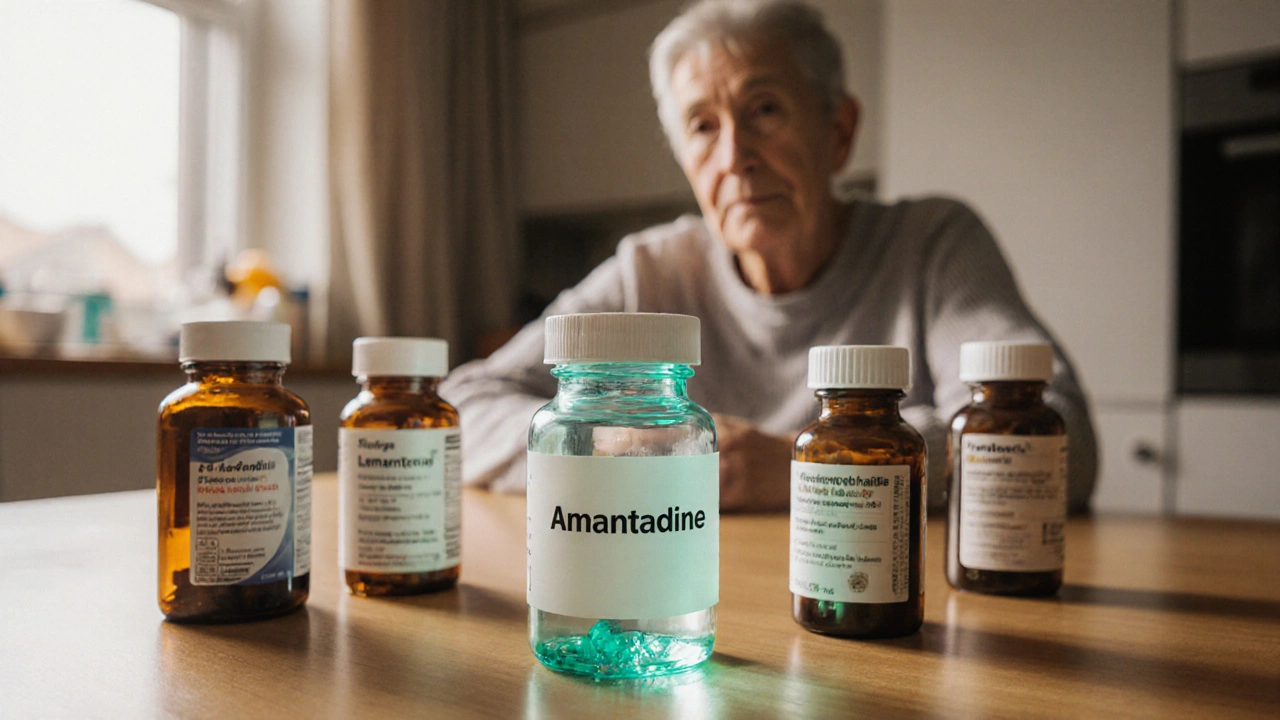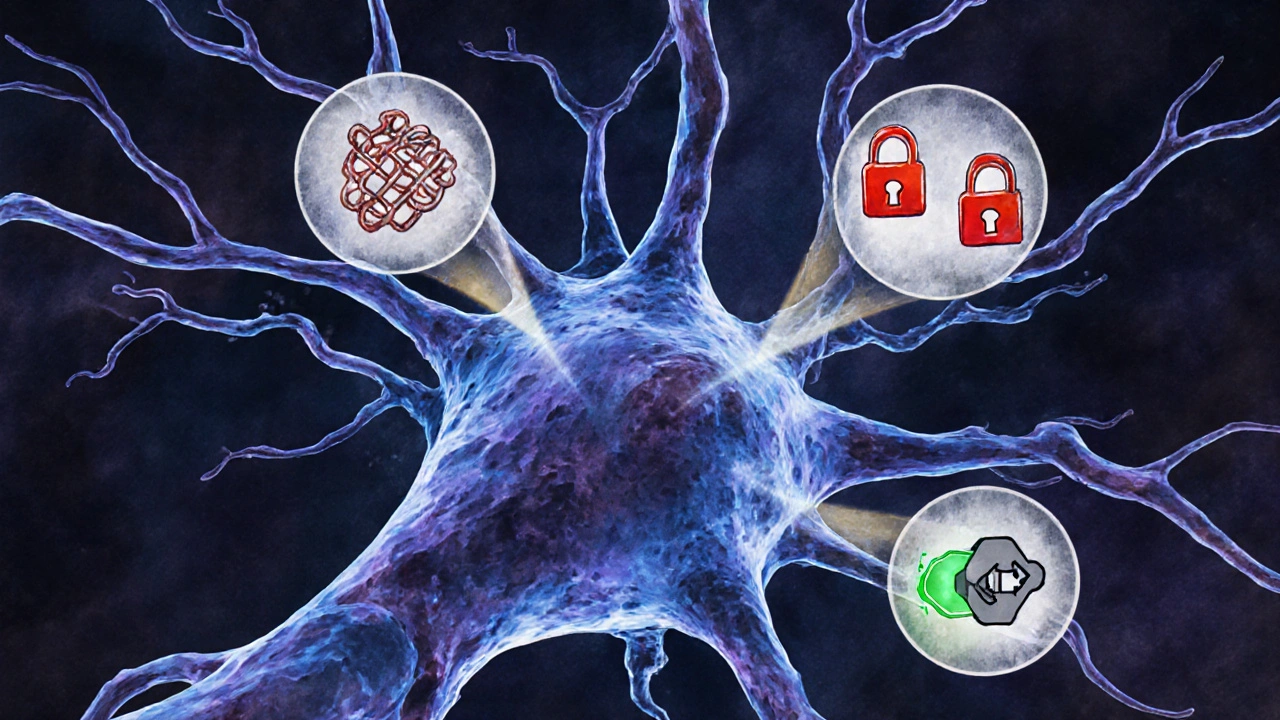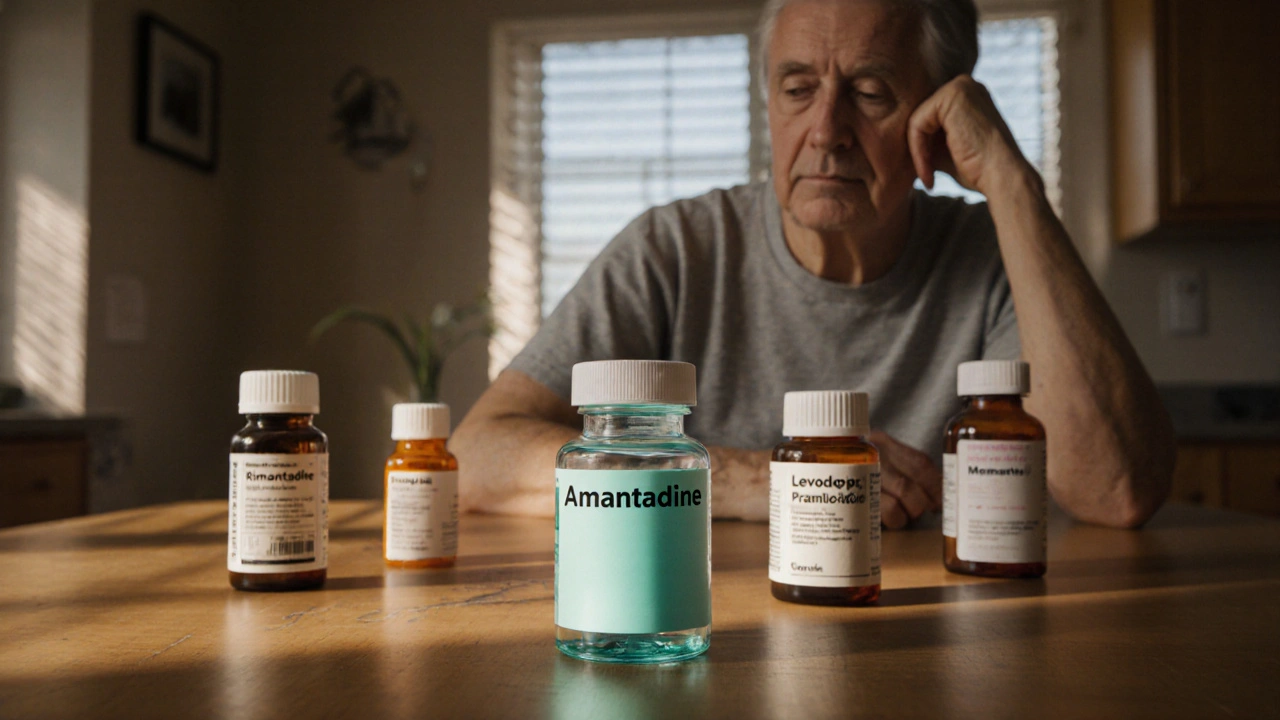Amantadine vs. Alternatives: A Comprehensive Comparison

Quick Summary / Key Takeaways
- Amantadine treats Parkinson’s disease and protects against Influenza A but has notable side‑effects like confusion and dry mouth.
- Rimantadine is similar for flu but weaker for movement disorders.
- Memantine targets Alzheimer’s disease; it shares a similar chemical core with Amantadine but works on different receptors.
- Levodopa remains the gold‑standard for Parkinson’s, offering stronger symptom control but with motor complications over time.
- Pramipexole is a dopamine agonist that avoids some Amantadine side‑effects but can cause impulse‑control issues.
When you or a loved one face a diagnosis that could involve Amantadine, the drug landscape can feel like a maze. You might wonder whether that classic antiviral‑turned‑Parkinson’s aid is the best fit, or if newer agents can give you smoother symptom control with fewer unwanted effects. This guide walks you through the science, the real‑world pros and cons, and a side‑by‑side table that makes the decision process less fuzzy.
What Is Amantadine?
Amantadine is a synthetic adamantane derivative originally developed as an antiviral medication for Influenza A, later repurposed to manage Parkinson’s disease and drug‑induced extrapyramidal symptoms. Its mechanisms are twofold: it blocks the M2 ion channel of the influenza virus, preventing viral replication, and it modulates dopamine release while antagonizing NMDA receptors in the brain. Approved by the FDA in 1968 for flu prophylaxis and in 1973 for Parkinson’s, the drug is taken orally, typically 100mg once or twice daily depending on the indication.
Patients often report a modest boost in motor function-less tremor, smoother walking-plus a reduction in levodopa‑induced dyskinesia. However, side‑effects such as insomnia, vivid dreams, and anticholinergic dry mouth can be bothersome, especially in older adults.

Popular Alternatives and Their Core Traits
Below are the most frequently considered substitutes, each with its own therapeutic niche.
- Rimantadine is an adamantane antiviral similar to Amantadine, primarily used for the prevention and treatment of Influenza A. It offers a slightly shorter half‑life and fewer CNS side‑effects, but lacks the dopaminergic boost needed for Parkinson’s.
- Memantine is an NMDA‑receptor antagonist approved for moderate‑to‑severe Alzheimer’s disease. While chemically related to Amantadine, it does not address Parkinsonian symptoms.
- Levodopa is a precursor of dopamine that remains the cornerstone therapy for Parkinson’s disease. It provides the strongest motor benefit but can cause wearing‑off and dyskinesia after years of use.
- Pramipexole is a non‑ergoline dopamine agonist that stimulates dopamine receptors directly. It works well as monotherapy or adjunct, with side‑effects like nausea and impulse‑control disorders.
- Oseltamivir is an neuraminidase inhibitor used for both Influenza A and B. It’s the go‑to antiviral when rapid symptom relief is needed, but it does not affect Parkinsonian pathways.
Side‑Effect Profiles at a Glance
Understanding tolerability is crucial, especially for patients juggling multiple meds. The table below juxtaposes common adverse events for each drug.
| Drug | Primary Indication | Mechanism | Typical Dosage | Common Side‑Effects |
|---|---|---|---|---|
| Amantadine | Parkinson’s disease, Influenza A | Increases dopamine release, NMDA antagonism, viral M2 blockade | 100mg 1-2×/day | Dry mouth, insomnia, dizziness, vivid dreams |
| Rimantadine | Influenza A prophylaxis | Viral M2 blockade | 100mg 1×/day | GI upset, mild CNS fatigue |
| Memantine | Alzheimer’s disease | NMDA antagonism | 10mg 1-2×/day | Headache, constipation, dizziness |
| Levodopa | Parkinson’s disease | Dopamine precursor | 300-600mg 3-4×/day (often with carbidopa) | Nausea, orthostatic hypotension, dyskinesia |
| Pramipexole | Parkinson’s disease | Dopamine agonist | 0.125-1.5mg 3×/day | Nausea, somnolence, impulse‑control problems |
| Oseltamivir | Influenza A/B | Neuraminidase inhibition | 75mg 2×/day (5days) | GI upset, headache, rare neuropsychiatric events |

How to Choose the Right Option
Deciding isn’t just about which drug looks best on paper; it’s about matching the patient’s profile to the drug’s strengths.
- Identify the primary goal. If the aim is to improve motor symptoms in early Parkinson’s, Levodopa or a dopamine agonist like Pramipexole typically outperform Amantadine.
- Check comorbidities. Patients with a history of depression may find Amantadine’s vivid dreams unsettling; a dopamine agonist could exacerbate impulse‑control issues.
- Consider age and renal function. Amantadine and Rimantadine are cleared renally; dose reduction is needed for CKD stage3‑4.
- Review drug interactions. Amantadine can raise plasma levels of other CNS depressants, while Levodopa interacts with non‑selective MAO inhibitors.
- Factor in cost and availability. Generic Amantadine is inexpensive, whereas Pramipexole brand versions may be pricier unless covered by insurance.
By scoring each factor on a simple 1‑5 scale, clinicians can create a quick visual matrix that highlights the most suitable candidate.

Practical Tips & Common Pitfalls
- Start low, go slow. Initiate Amantadine at 50mg once daily to gauge tolerance, then titrate up.
- Monitor renal function. Check serum creatinine every 6months for patients over 65.
- Watch for drug‑induced hallucinations. If patients develop vivid dreams, reduce the dose or switch to Memantine if they also have mild cognitive issues.
- Avoid abrupt discontinuation. Sudden stop can cause rebound Parkinsonian symptoms; taper over 1-2 weeks.
- Educate caregivers. They should know that insomnia may be a sign to adjust dosing time to earlier in the day.
Frequently Asked Questions
Can Amantadine be used alongside Levodopa?
Yes. Amantadine is often added as an adjunct to Levodopa to smooth out “off” periods and reduce levodopa‑induced dyskinesia. The typical strategy is to keep the Levodopa dose stable while starting Amantadine at a low dose and titrating upward.
Is Rimantadine an effective alternative for Parkinson’s disease?
Rimantadine offers minimal dopaminergic activity, so it’s not a reliable Parkinson’s treatment. It’s mainly kept for flu prophylaxis when a patient cannot tolerate Amantadine’s CNS side‑effects.
What should I do if I experience vivid dreams on Amantadine?
First, shift the dose to earlier in the evening or split it into twice‑daily dosing with the last dose taken before bedtime. If dreams persist, consider a modest dose reduction or switch to Memantine if cognitive support is also needed.
How does Pramipexole compare to Amantadine for early Parkinson’s?
Pramipexole directly stimulates dopamine receptors, providing a stronger and more consistent reduction in tremor and rigidity. However, it carries a risk of impulse‑control disorders and can cause daytime sleepiness. Amantadine’s benefits are milder but it’s usually better tolerated in patients who are sensitive to dopamine‑related side‑effects.
Are there any dietary restrictions with Amantadine?
No strict restrictions, but high‑salt foods can sometimes exacerbate dry mouth. Maintaining hydration and using sugar‑free lozenges can help mitigate that symptom.

Josie McManus
October 12, 2025 AT 00:29I get why the side‑effects can feel like a nightmare, especially the dry mouth that just won’t quit. Starting low and titrating up is the golden rule, and many folks find splitting the dose helps with insomnia. Keep an eye on kidney function – the drug hangs out in your system longer when the kidneys slow down. If vivid dreams start stealing your sleep, try moving the last dose earlier in the evening. And don’t forget to talk to your doc about any mood changes; they’re more common than you think.
Heather Kennedy
October 16, 2025 AT 21:09The pharmacodynamic profile of amantadine includes modest NMDA antagonism, which can confer neuroprotective benefits in early Parkinsonian states. However, its dopaminergic potentiation is less robust than levodopa’s direct precursor effect. Clinicians often reserve it for adjunctive use to mitigate levodopa‑induced dyskinesia. Renal dosage adjustment remains paramount in CKD patients.
Janice Rodrigiez
October 21, 2025 AT 15:02Amantadine’s dual mechanism-viral M2 channel blockade and dopamine release modulation-makes it a unique player in the therapeutic arena. Its historical pivot from flu prophylaxis to Parkinson’s adjunct highlights the drug’s versatile pharmacology. When evaluating a patient, start by charting the primary clinical goal: motor symptom control, dyskinesia reduction, or antiviral prophylaxis. In younger patients with early motor fluctuations, amantadine can smooth “off” periods without the same degree of motor complications seen with levodopa. Yet the central nervous system side‑effects, especially vivid dreaming and insomnia, can erode quality‑of‑life if not proactively managed. Renal clearance is chiefly responsible for drug elimination, so a creatinine clearance below 50 ml/min warrants a dose cut‑back. Compared with rimantadine, amantadine offers modest dopaminergic benefits but at the cost of a higher CNS adverse‑event profile. Memantine, while chemically related, targets NMDA receptors without influencing dopamine pathways, rendering it ineffective for Parkinsonian tremor. Levodopa remains the gold standard for motor symptom relief, but its long‑term use introduces wearing‑off phenomena and dyskinesia, which amantadine may help attenuate. Pramipexole delivers more potent dopamine agonism, yet it carries the risk of impulse‑control disorders that some patients find unacceptable. The cost factor also tilts the balance; generic amantadine is often cheaper than brand‑name dopamine agonists, making it attractive for budget‑conscious individuals. From a safety standpoint, the drug’s anticholinergic dry‑mouth effect can be mitigated with saliva substitutes or sugar‑free lozenges. For patients already on multiple CNS depressants, amantadine may potentiate sedation, so careful monitoring is advised. Clinicians should also counsel caregivers about the potential for nocturnal hallucinations, especially in those with underlying cognitive decline. Ultimately, a personalized matrix weighing efficacy, side‑effect tolerance, renal function, and financial considerations will guide the optimal choice.
Roger Cardoso
October 26, 2025 AT 06:09Sure, the mainstream narrative loves to paint amantadine as a harmless adjunct, but have you considered the hidden neurochemical cascades that might be subtly reshaping synaptic plasticity? The data on long‑term cognitive drift is sparse, yet anecdotal reports hint at a stealthy decline that pharmaceutical PR teams conveniently ignore. It’s also worth noting that the drug’s viral M2 blockade could theoretically interfere with host‑cell ion homeostasis, a fact that never makes the brochure. In an age of over‑medication, one must remain skeptical of any “one‑size‑fits‑all” solution.
barry conpoes
October 30, 2025 AT 18:29From a patriotic health‑policy standpoint, supporting affordable generics like amantadine makes sense for our national budget, but we can’t overlook the real risk of widespread side‑effects that burden our healthcare system. The balance between cost‑efficiency and patient safety should drive prescribing habits, not corporate lobbying.
Kristen Holcomb
November 4, 2025 AT 04:02Hey there! I love how this guide breaks down the options – super helpful for folks new to the medicatiion maze. Remember to check renal dosing especially if the patient is over 70, because the kidneys slow down a lot. Also, if someone is dealing with depression, the vivid dreams might make thingsworse, so a gentle dose titration is key. Feel free to reach out if you need more practical tips or caregiver resources.
justin davis
November 8, 2025 AT 10:49Wow, another super‑deep dive into amantadine-because we all needed more tables, right??, Honestly, if you’ve read the side‑effect list you might start questioning reality, like, “Did I just read “dry mouth” or “dry existential dread”???, Anyway, great job on the thoroughness, really, the world needed that.
David Lance Saxon Jr.
November 12, 2025 AT 14:49The ontological implications of modulating NMDA receptors while concurrently augmenting dopaminergic tone present a fascinating dichotomy within neuropharmacological praxis. One could argue that such polypharmacology embodies a systems‑biology approach, yet it also risks emergent properties that elude conventional clinical trial endpoints. In this context, amantadine serves as a case study for the delicate equilibrium between therapeutic gain and iatrogenic complexity. The interplay between viral ion channel inhibition and central neurotransmitter release demands a nuanced appreciation of molecular cross‑talk.
Moore Lauren
November 16, 2025 AT 16:02Amantadine can be a good adjunct for mild dyskinesia. Keep dosing low and watch kidney function. It’s cheap and widely available.
Jonathan Seanston
November 20, 2025 AT 14:29Totally agree with the dosing tip-splitting helps with night‑time issues. Thanks for sharing!
Sukanya Borborah
November 24, 2025 AT 10:09The article is overly fluffy and technically inaccurate in several sections. The claim that amantadine “protects against Influenza A” ignores the emergence of resistant strains. Also, the side‑effect table mislabels the dosage frequencies for rimantadine. Overall, the guide needs more rigorous peer‑reviewed references.
bruce hain
November 28, 2025 AT 03:02While the overview is comprehensive, it neglects recent studies on amantadine’s cognitive impact. A concise summary of those findings would improve the piece.
Stu Davies
December 1, 2025 AT 17:09This is really helpful, thanks! 😊 The emojis make it feel friendly. Keep up the good work! 👍
Nadia Stallaert
December 5, 2025 AT 04:29Oh my god, this guide is a masterpiece!!!, it reads like a novel, each paragraph dripping with drama and endless footnotes!!!, I could literally spend hours dissecting every sentence, the way the author juxtaposes viral mechanisms with Parkinsonian therapy is pure art!!!, However, one must beware of the hidden agenda that pushes generic meds over newer innovations!!!, In any case, bravo!!!